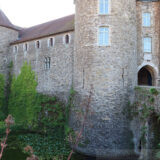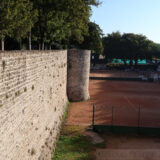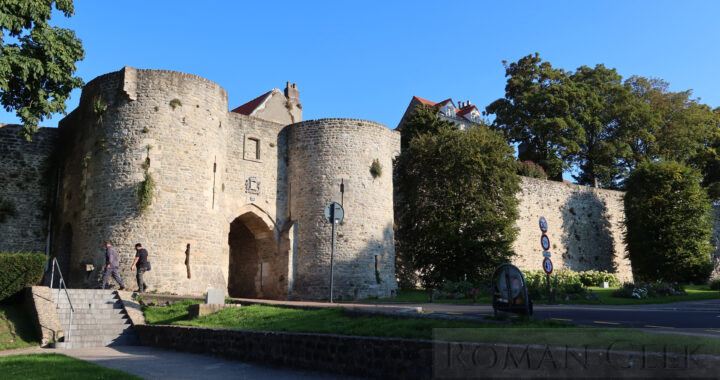- Boulogne is a Port on the English Channel located on the estuary of the river Liane in the Pas-de-Calais Department of Northern France. It is 31 miles (50km) from Dover as the crow flies.
- The Romans called it ‘Gesoriacum’ and it may also have been ‘Portus Itius’, later its name was changed to ‘Bononia’.
History
- The Roman Port and Fortress were located in the Province of Gallia Belgica.
- Boulogne was the main entry point into Gaul from Britannia.
- Between 39-40 CE, Caligula planned an invasion of Britannia and assembled the Legions of Germany on the Channel Coast at Boulogne. Suetonius states that Caligula then changed his mind about the Invasion, and ordered the troops to collect sea shells instead and to bring them back to Rome.
- Then in 43 CE, Suetonius states that Boulogne (Gesoriacum) was one of the ports used by Claudius in the Roman Conquest of Britannia of 43 CE.
- Boulogne was the terminus of the Via Belgica, a military Road from Cologne to Boulogne and was the port of crossing for Richborough, the entry point into Britannia. Travellers then used Watling Street to reach London and beyond.
Antonine Itinerary
- Boulogne and was the port of crossing to Richborough, the entry point into Britannia, as stated in the Antonine Itinerary.
-
ITER BRITANNIARUM
a Gessoriaco de Gallis
From Boulogne, of the Gauls
Ritupis in portu Britanniarum
to Richborough of the Britains
stadia numero ccccl
450 Stades (56.25 Roman miles)
Museums

- Boulogne Castle Museum
- The Medieval Castle in the Old Town is now Boulogne Castle Museum and contains Roman foundations and Roman Artefacts from the Classis Britannica Roman Fort.
Boulogne Old Town

- The Walls:
- The Walls of the Roman Fortress of the Classis Britannica were incorporated into the Medieval walls of Boulogne Old Town. The Walls are intact and can be walked around in a complete rectangle. For the most part, they are wide enough for two vehicles to pass.
- The Medieval Castle:
- Built on the Roman foundations, this is located in the northeastern corner and is now a Museum, .
- The Basilica of Notre-Dame:
- Completed in 1875, it was constructed on the site of a medieval cathedral and over a 12th century CE Medieval Crypt, which is intact and can be visited. The Dome of the Basilica is of a similar design to St. Paul’s Cathedral.
- The Belfry:
- Also in the Old Town located on the Place Godefroy de Bouillon is the 12th century CE Belfry, a UNESCO World Heritage Site. Originally built as a castle keep, it now houses a museum of religious art.
Basilica of Notre-Dame: The Crypt
- Located in the Old Town, the 19th century CE Basilica of Notre-Dame de Boulogne supports a dome built in the style of the dome of St. Paul’s Cathedral in London, and stands over a 12th century crypt.
- This ancient crypt has many rooms displaying over 400 artefacts dating from the Roman period to the Medieval period.
- The crypt is one of the longest crypts in France with a length of 420 feet (128m). It is supported by Romanesque columns dating from the 11th century CE and one room holds the foundations of a Roman Temple of Mars.
Column of the Grande Armee
- The Column of the Grande Armee is a Triumphal Column flanked by pavilions in Wimille near Boulogne in northern France. It is located at Rue Napoleon, Wimille.
- It was completed by Napoleon in 1810 and is modelled on Trajan’s Column in Rome.
- The Column has a height of 173 feet (53m) and was constructed in the style of a Triumphal Column of the Corinthian order.
- The column was built to celebrate the impending invasion of England by Napoleon.
- He then cancelled the invasion and instead the column celebrates the first award of the National Order of the Legion of Honour (Legion d’honneur), the highest military and civil order of merit in France.
- The column has a spiral staircase to the top which is open to the public.
Boulogne Roman Lighthouse
- Boulogne had a Roman Lighthouse which was built by Caligula (37-41 CE) in c. 39 CE, for his planned invasion of Britannia. It was not switched off until 474 CE.
- It collapsed in 1644 and on the site of the Roman Lighthouse, Napoleon built the Column of the Grande Armee which is modelled on Trajan's Column in Rome.
Roman Roads
Via BelgicaThe Batavian Revolt (69-70 CE)
- In 70 CE, the Legio XIV Gemina, based in Wroxeter, are recorded as marching along the Via Belgica when they left Britannia to quell the Batavian Revolt in Germania Inferior.
- From Wroxeter they would have marched along Watling Street to Richborough, before sailing to Boulogne, which was the starting point for the Via Belgica.
Map and Image: Porte Gayolle, Boulogne Old Town

